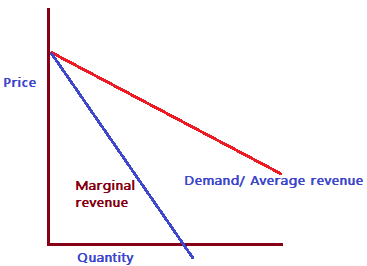Monopoly
The Greek words mono, which means one, and poly, which means seller, is the origin of the word "monopoly." Therefore, a monopoly is the market structure for a good or service where there is only one supplier and there are no direct competitors. As the only vendor of the item, the seller has complete control over its supply. Therefore, a monopolist sets prices. He is unafraid of what his competitors do.
Generally speaking, monopolies exist in municipal utilities and public utility firms, including those that provide water, electricity, natural gas, professional sports teams, etc. Market demand has the power to alter monopoly pricing. Monopoly has a downward-sloping demand curve.
Producers lower their pricing to boost sales. A barrier to entry for businesses is the existence of legislative limitations, economies of scale, and control over vital resources. The legal constraints include licenses, other entrance restrictions, and patents, which denote exclusive rights for a set period of time. Creating big volumes at the lowest possible cost is what is meant by economies of scale.
Causes for Raising Monopoly
- The primary sources of raw materials, which are crucial for the production process, are subject to a single right or control for the firm.
- A company that produces a good or uses a production method with specific quality and character is given patent rights by the government.
- Long-running businesses may receive a great deal of goodwill from their customers.
- The majority of public monopolies exist in the area of public utilities like power, electronics, and communication media. Government monopolies that were established by the legislation such as postal services. The promotion of public welfare is the goal of this strategy.
- Due to the high transportation expenses required to sell on the international market, many local businesses may have monopolies.
Features of Monopoly
- Single seller and a large number of buyers
- No close substitute goods
- Barriers to entry of new firms
- No perfect information about the market for both buyers and seller
- Monopoly as a price maker
- Downward slope of the demand curve(AR curve) because of the law of demand which states that "higher the price lower the demand and vice-versa.
- Monopolists can alter the market price by increasing or decreasing output level.
- The main objective of the firm is to maximize profit.
= TR/Q - TC/Q
= (P - ATC) x Q
The Monopolist's Profit in the long run and short run
Because there is a barrier to entry for new businesses, monopolies can maintain super-normal earnings over the short and long terms. As is true for all businesses, revenues are increased when MC = MR.
Generally, market competition, which is zero in a pure monopoly, determines the level of profit. When profits are maximized, MC = MR, with the output being Q and the price being P.
Types of Monopoly
Pure Monopoly: Monopoly without a close substitute and with a strong legal barrier to entry
Imperfect Monopoly: Monopoly with few alternative substitute
Natural Monopoly: Monopoly because of natural talent and skills such as singer, actor, surgeon
Bilateral Monopoly: Monopoly with a single buyer and seller in which a single firm must purchase all the raw materials.
Benefits and drawbacks of monopoly
Benefits:
Encouraged business persons during the great depression by assuring profit margin.
It might be acceptable if a natural monopoly exists.
Promotes research and development
Supports creative thinking
Gaining economies of scale can benefit consumers
Negative aspects:
Limiting the amount of output released onto the market.
Demanding a higher price than in a market with greater competition.
Decreasing consumer surplus and economic well-being.
Limiting the options available to consumers.
Decreased consumer sovereignty
Conclusion:
A market structure with a single seller and numerous customers is advantageous for the production of essential and public products that raise welfare. Similar to this, the government can entice and motivate producers to produce goods and services for favorable market conditions when there is a producer depression.

